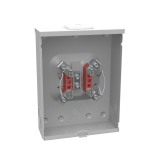texie
Senior Member
- Location
- Fort Collins, Colorado
- Occupation
- Electrician, Contractor, Inspector
As I mentioned in post #3, bonding the neutral is just one way of complying with 250.92 and 250.80. There are other methods such as I mentioned and detailed 250.92. The bottom line is all metallic items on the line side of the service disconnect must be bonded in a manner compliant with 250.92.Can I bring up one more thing that makes no sense, as far as inspectors and POCO goes. Where I'm at, my local inspectors (I'm pretty sure POCO doesn't like it either) hate it when you bond the neutral inside the meter. They've asked me multiple times when I'm getting inspections if I bonded it or not inside the meter can... Doesn't this go against code... 250.80 clearly states that all metal raceways and enclosures for service conductors and equipment must be bonded to the neutral. It's clear as day, or am I somehow reading this incorrectly? So any enclosure I have from service point to service disconnect must have the neutral bonded to the metal housing.
Note that most meter cans have non-removable factory bonds but in recent years meter cans have become available with field installable bonding jumpers. This is because sometimes meter sockets are needed for non-service applications. The point is you can bond the meter for a service by bonding to the neutral or any other method in 250.92. You still need a main bonding jumper in the service disconnect no matter how you comply with 250.92.


